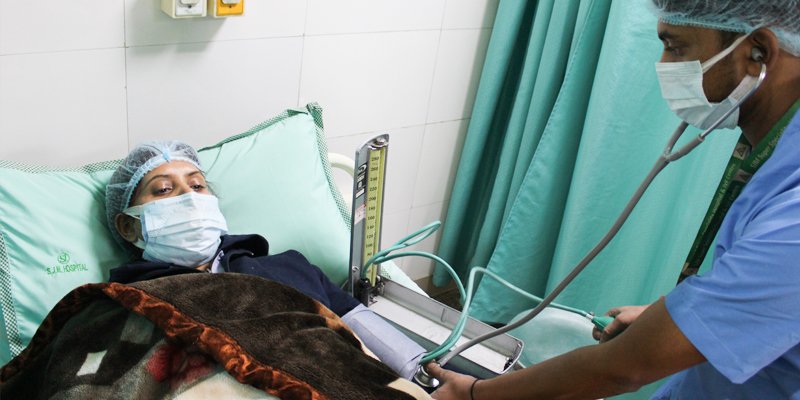
Laparoscopy
Laparoscopy (a keyhole surgery) is a type of surgical procedure that uses a laparoscope (a fiber-optic tube with an attached light and a camera) that is inserted in the belly button by making a small incision. This procedure is performed for various operative purposes and examines the pelvic cavity and reproductive organs.
Operative laparoscopy
It is a type of surgical procedure that is used to treat problems diagnosed during the diagnostic laparoscopy procedure.
Laparoscopy treatment helps to diagnose the causes of infertility like
- Fibroids
- Blocked fallopian tubes
- Uterus and ovaries abnormalities
- Pelvic adhesions
The doctor recommends laparoscopy treatment if one is experiencing the following concerns.
- Pain during sexual intercourse
- Severe menstrual cramps
- Pelvic pain
- Pelvic inflammatory disease
- Ectopic pregnancy
Benefits
- Correct tubal problems
- Low risks and quick recovery
- Help remove fibroids, cysts, endometrial deposits
- Helps correct infertility issues
- Improves the chances of females to get pregnant
- Minimally invasive surgery
- Treat PCOS and pelvic inflammatory diseases.
Procedure
Laparoscope helps evaluate the reproductive structures such as ovaries, fallopian tubes, and uterus. It diagnoses abnormalities that might interfere with a female ability to get pregnant. The abdomen is inflated with carbon dioxide gas to get good visibility of the internal organs. It uses surgical tools to correct or remove endometriosis, scar tissues, and fibroids. The surgeon uses a laser beam or electric current to remove or cut the tissue. The gas is then removed, and the abdomen is closed with stitches, usually causes little to no scarring.
After the treatment, the patient must take a rest for 2-4 days. One can experience some cramping in the abdomen area or mild nausea. Medications are prescribed to manage discomfort and also aids in early recovery.

Hysteroscopy
Hysteroscopy process uses a hysteroscope that enables to view the inside of the uterus along with the cervical canal. Hysteroscope is a type of narrow telescope containing a camera and small light inserted into the vagina and helps examine the cervix and the inside of the uterus. This procedure helps to diagnose and treat the cause of abnormal bleeding. It also helps to produce an image of the uterus for performing the diagnostic and operative function.
Advantages of hysteroscopy
- Short hospital stay
- Less recovery time
- Avoidance undergoing hysterectomy
- Avoid undergoing ‘open abdominal’ surgery
- Diagnose the cause of infertility
- Diagnose the cause of repeated miscarriages
- Evaluate small fibroids or polyps
- This treatment diagnoses problems related to the uterus, identify abnormalities of the uterine cavity, and also correct abnormalities
- This also helps identify and treat various gynecological problems including infertility, pelvic pain, or unexplained infertility, and irregular periods
- It is also used to remove displaced intrauterine devices (IUDs) and intrauterine adhesions.
Procedure
The procedure is performed on an outpatient basis. The patient is asked to wear a gown and empty their bladder prior to the procedure. The vaginal area is cleaned with an antiseptic solution, and then carefully a hysteroscope is inserted into the vagina through the cervix and then into the uterus. Then the area is examined for abnormalities, and biopsy samples and photographs are taken. If the fibroid is removed, then some specialized instrument is inserted through the hysteroscope. Once the examination is completed, the hysteroscope is removed.
Operative hysteroscopy
After performing diagnosis, the hysteroscopic technique is used to remove fibroids, cysts, and correcting a blocked fallopian tube that is affecting the flow of the egg.
The procedure also helps diagnose intrauterine lesions within fallopian tubes. The procedure also helps remove mucosal myomas that are a major factor to cause infertility. It is a safe treatment for restoring menstrual function and improves the chances of natural conception. It also removes endometrial polyps and corrects uterine abnormalities.
This procedure is safe, with a lower risk of complications if performed by an expert. After the hysteroscopy post-procedure, one can feel mild discomfort similar to periods of pain. The cramps will settle in a few days, and pain medicines are prescribed to manage discomfort. It is advised that the patient must avoid drinking alcohol, sexual activity for a few after the procedure to avoid any infection risk.
For more information about Hysteroscopy treatment in Noida visit today at SJM IVF.